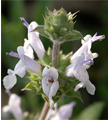Black sage is a small, highly aromatic, evergreen shrub of the genus Salvia (the sages) native to California, and Baja California. Known by its scientific name Salvia mellifera, black sage is common in the coastal sage scrub of Southern California and among riversidean scrub ranges \northern Baja California. Black sage has a dark appearance, especially during drought.
Black sage is a perennial shrub that grows approximately 3.3 feet to 6.6 feet tall. It is covered with simple hairs with some glandular hairs, which makes it highly aromatic. The leaves are oblong-elliptic to obovate in shape and are about 0.98–2.76 inches long. The upper surface of the leaf is somewhat glabrous, while the lower surface of the leaf is hairy.
The inflorescence occurs in 0.63–1.57 inch wide clusters. The flowers are usually a pale blue or lavender color, and rarely a pale rose color. The upper lip of the flower is 2-lobed. The style and stamens are slightly exserted. The fruit produced by the black sage is a schizocarp composed of four 0.079–0.118 in) brown nutlets.
Like many plants of the coastal sage scrub, black sage is seasonally dimorphic. During the rainy period, leaves are relatively large. These are replaced during the dry summer months with smaller leaves that tend to be curled to reduce transpiration. These summer leaves can respond quickly to a summer shower, but the lush green leaves of winter and spring do not reappear until winter rains begin.
Black sage grows in the coastal sage scrub and lower chaparral plant communities. It occurs from sea level to 3,900 feet elevation. Black sage is able to grow on a variety of different soils, including sandstone, shale, granite, serpentinite, and gabbro or basalt. It is semi-deciduous, depending on the location and severity of drought, shallow rooted, and drought tolerant by leaf curling rather than drought-avoiding through leaf drop.
Black sage readily hybridizes with three other coastal scrub Salvias: Salvia apiana (white sage), Salvia leucophylla, and Salvia clevelandii. It rarely hybridizes with the annuals Salvia columbariae and Salvia carduacea.
The Chumash people used a strong sun tea of the leaves and stems of the plant. This was rubbed on the painful area or used to soak one’s feet. The plant contains diterpenoids, such as aethiopinone and ursolic acid, that are pain relievers.
The Black Sage also produces a nectar that Black Sage honey is made from. This honey is typically peppery and strong, and is prized as a rare honey due to the plant’s dry climate. Black Sage honey can only be made when specific rain conditions are met and the plant produces enough nectar.
SBCSentinel
News of note from around the largest county in the lower 48 states.

